

Ryuichi Sakamoto Debuts "Raindrops" From His Score For Nagasaki: Memories Of My Son. Could you tell me a little about "Raindrops" — what was your idea behind this piece in particular?
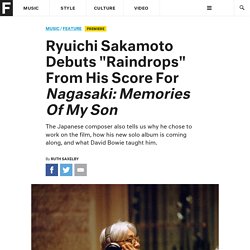
The music comes right after the images of raindrops. My idea was to link the sound of rain into the harp and then the piano on the F note for enjoying the sound and color changes. And obviously, I was thinking of Chopin’s "Raindrop" prelude. You mentioned in our interview last year that you were anxious to start work on a new solo album. How is that coming? After Nagasaki, I finished another Japanese film entitled IKARI (the English official title is Rage), which will be out in September in Japan. I understand that your score for Merry Christmas, Mr. He was so intelligent and charming. Lexiques des Musiques d'Asie orientale (Chine, Corée, Japon, Vietnam) Lexiques des Musiques d'Asie orientale (Chine, Corée, Japon, Vietnam) Les musiques d'Asie orientale forment un univers à part : multiplicité des instruments, longue histoire, écriture musicale, théorie, hétérophonie, pentatonisme coexistant avec un système de douze sons à l'octave, allures souples et variables, énergie du souffle.
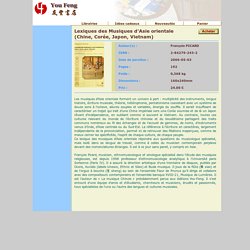
Il serait insuffisant de caractériser un trajet qui irait d'une Chine impériale vers une Corée soumise et de là un Japon rêvant d'indépendance, en oubliant comme si souvent le Vietnam. Discographie. UNESCO Secteur de la culture - Patrimoine immatériel - Convention 2003 : La Collection UNESCO de musique traditionnelle du monde comprenait plus d’une centaine d’enregistrements audio des pionniers de la musique traditionnelle du monde publiée de 1961 à 2003 par sur un certain nombre de maisons de disques.

Mieko Miyazaki. Mieko MIYAZAKI est une joueuse de koto - instrument traditionnel du Japon proche parent de la cithare, formée auprès des maîtres japonais et honorée par de nombreuses distinctions nationales dans son pays.
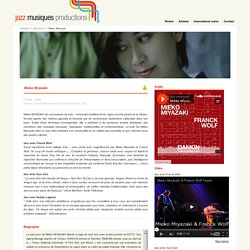
Dotée d'une technique incomparable, elle a participé à de nombreux projets artistiques aux carrefours des musiques baroques, classiques, traditionnelles et contemporaines. Okinawan Music. Robert Garfias Department of Anthropology UCI I have been invloved in the study of Okinawan music for some years now.
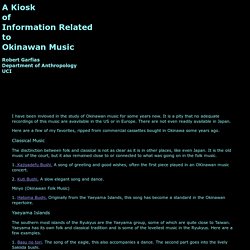
Reiko Kimura Biography. Reiko Kimura's first recording on Celestial Harmonies is Music for Koto (13191-2) In notes to a recently released CD with Kimura Reiko's performances of several of Miki Minoru's works, Miki describes her as an "almost perfect nijugen performer.
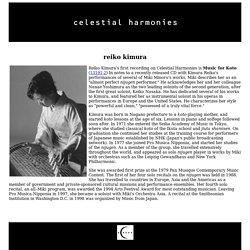
" He acknowledges her and her colleague Nanae Yoshimura as the two leading soloists of the second generation, after the first great soloist, Keiko Nosaka. He has dedicated several of his works to Kimura, and featured her as instrumental soloist in his operas in performances in Europe and the United States. He characterizes her style as "powerful and clean," "possessed of a truly vital force. " Kimura was born in Nagano prefecture to a koto-playing mother, and started koto lessons at the age of six. Lessons in piano and solfege followed soon after. An Error Occurred Setting Your User Cookie. Bridges Library Catalog /All Locations. Chronological table. Home > biography > chronological table This post is also available in: Japanese Shorter biography is also available. 1968 Born in Nagoya, Japan 1974 Started to learn the harmonium at the Wakaba Kindergarten 1977 At the age of 8 he did spontaneously his first composition in 16-bars while he was sick at home.
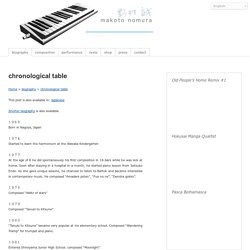
INSTANTS CHAVIRÉS > #JAPANESE NEW MUSIC FESTIVAL 2014# RUINS alone TSUYAMA ATSUSHI solo KAWABATA MAKOTO solo ZOFFY AKATEN ZUBI ZUVA X PSYCHE BUGYO ACID MOTHERS TEMPLE SWR. YAMANE AKIKO OFFICIAL BLOG. Satsukishibano.com. W/ 尾島由郎 夜のカフェライブ3@Spiral Café 2014.2.3. 柴野さつき (Satsuki Shibano):piano w/ 尾島由郎 (Yoshio Ojima):electronics & manipulation 日程: 2014.2.3(Mon) 時間:Start 1st 20:15 / 2nd 21:15 (入替無し) 場所:スパイラルカフェ(スパイラル1F) 料金:無料(投げ銭制・飲食代別途) ※お帰りの際,レジ横の「投げ銭箱」にチャージをお入れください。
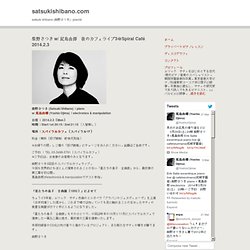
金額はご自由です。 ”ÊŽá—ŽïãS. Japon. Shomyo : psalmodie bouddhique. An Unofficial Keiji Haino Discography - Guest Appearances. Volcanic Tongue: Underground Music Mailorder & Shop. William Hooker with Eyvind Kang & Bill Horist The Seasons Fire Important Records Imprec-133 CD £6.99 "This all-star trio features William Hooker on drums, Eyvind Kang on violin and guitar and Bill Horist on guitar.
Sync'd up like they've been playing together for eternity these recordings represent a dramatic paradigm shift in the art of improvisation. These three thoroughly modern artists scan jazz, new music and noise - stretching it all out and putting it back together within the expansive boundaries of these tremendously compelling high energy recordings. William Hooker has performed as a leader of many ensembles of improvised and new music.
Accompanying musicians have included: Billy Bang, Thurston Moore, David Murray, David S. Video Game Reviews, Tech Gadget Reviews, and Anime Reviews. When I started watching "Samurai Champloo" a couple years back, my ears caught the sound of an amazing rapper.

As the curious ducky that I am, after I watched the first episode I went online to check out who it was. Ueda/Offermans. The Duo Ueda/Offermans The most remarkable Japanese/Dutch music Duo Ueda Offermans (Junko Ueda and Wil Offermans) combines in their concerts the Japanese satsuma-biwa & voice and the Western flutes.

Since 1988 they have been performing their compositions and improvisations. Their music can be characterized by exploring the integral time-space between different cultures and between ancient and modern. During the last years, the duo has appeared at numerous music festivals (i.e. Musique Action Nancy, Singapore Festival of Arts, Quebec Summer Festival, New Music Festival Middelburg, Musica Contemporenea Bogota) and has toured extensively all over the world and exchanged with local musicians and composers.
Tomoka Nagasu - The International Shakuhachi Society. Ueda/Offermans. Asian Cultural Council. Return to complete list Shin-Shin Wang Taiwan Ms. Wang is an established Nanguan singer and pipa player, and the director of Hsin Hsin Nanguan Ensemble. Junko Ueda. LivreMusiqueTraditionJapon. Akira Tamba Des origines au XVIe siècle Cet ouvrage explore les trois formes les plus anciennes de la musique japonaise dans leur fonction rituelle ou cérémonielle : le shômyô, chant liturgique qui appartient au patrimoine de la pensée bouddhique, le gagaku, musique de cour, dont on sait qu'il est la plus ancienne musique harmonique du monde jouée aujourd'hui, enfin la musique de biwa, chant épique accompagné de ce luth, qui relate les épopées médiévales du Japon.
Une part importante est faite aux instruments et aux exemples musicaux transcrits en notation occidentale. Intro à la musique japonaise. Par Akira TAMBA. Music_en of NKBH-西原鶴真 琵琶を弾く!? Traditional BIWA The stringed instrument which has the origin in ancient Persia as well as lute etc.Through the Silk Road, the musical instrument which became PIPA in Chinawas introduced into Japanaround the 7th or 8th century, and became a biwa.It was a court musical instrument in the beginning.After that,a blind priest began to play Biwa and tell that the past samurai battle.Therefore, the biwa became a samurai's musical instrument gradually.
In the contemporary,In 1967, Tsuruta sensei first played on the piece November Steps,composed by Takemitsu Toru.This was the first time traditional Japanese musical instrumentswere combined with western orchestra. Through November Steps,Tsuruta Kinshi exposed the world outside of Japan to the deep beauty of the biwa. Kakushin Nishihara.